No. 19, Vol. 2. Autumnal Equinox 2010
Appendix: 91 Angelic Governors and their Sigils
John Dee and Edward Kelley's Great Table, Part II
(The Angelic Governors and Black Cross)
by Teresa Burns and J. Alan Moore
In the last issue, we started our discussion of John Dee and Edward Kelley's Great Table of Earth by noting that this Table, with its Four Watchtowers and Black Cross, is the last received and most complex component of a system that many have used, proclaimed as powerful, and cautioned others about using haphazardly. We suggested it might be a wise idea to understand what Dee and Kelley thought the table contained and was for,[1] and what preliminary understandings they would have brought to it,[2] before using it! Hopefully that discussion laid the groundwork for working through some of the most vexing questions about the reception, construction, and development of the so-called Enochian Tablets.
In this issue, we'll look at some of those questions, especially the possible causes of multiply lettered or differently lettered Tablets. If one uses Dee's reported lettering and corrections, and understands hierarchies implicit in the Enochian (or Angelic or Ophanic) material, the system itself suggests a solution to the blind, via the names of the Angelic Governors.[3] Following that, we'll look at how three of the Governors create the Black Cross, and see whether they implicitly suggest the Tablet of Union used by many modern esotericists. Then, we'll look at the name "PARAOAN" and suggest that where these letters and an added "L" fall on our reconstructed Great Table implies a Table that only connects in dimensions higher than three.
That will set the groundwork for looking at different directional and elemental attributions to the Tablets, and understanding how to project the Tablets upon the celestial sphere. (For instance, do modern projections of the material onto the night sky make sense in terms of the original material?[4]) Answering these questions and determining how certain correspondences have been made may also suggest temporal and alchemical attributions, and inform a system of coloring the individual Watchtowers.
First, however, we need to remember that this material comes through the combined energetic space of two men, John Dee and Edward Kelley, who appear to have not always gotten along but who seemed unable to produce such material separately. Dee left behind—by far—more writing than Kelley. Much of the writing 1582-1585 that is not a direct record of an "angelic conversation" is Dee's laborious tabling out of information and trying to make sense of what they had received previously. Logically then, Dee's lifelong habit of seeking correspondences and hierarchies between different geometric and linguistic patterns will affect his attempts to understand the material. (In fact, Theorem XX of the Monad suggests one way he might have understood the Great Table, based on this earlier work.)
The last part of Dee and Kelley's angelic conversations—the time during which Dee would presumably have had the greatest understanding—is lost. Therefore we have no way of knowing if Dee (or Kelley's) awareness of the material further blossomed in some way after the 1587 "Third Action" in Trebon[5] (recorded in ms. Cotton Appendix XLVI) or the material compiled in Sloane ms. 3191.
Also, we must remember that Dee sometimes hides material,[6] and it is often hard to tell what is a magickal blind, and what is Dee not understanding or making errors. So before we look at which parts of the Enochian system govern others, let's look briefly at the problem of working through magickal blinds and determining what Dee did or did not know.
Magickal Blinds?
The Sigillum Dei Aemeth or "Seal of Truth" is a complex condensation of planetary magic; indeed, some have considered it a condensation of all medieval planetary magic,[7] and it may also be seen as a condensation of Dee's geometric ideas in the Hieroglyphic Monad through Theorem XVII.[8] If any part of the angelic work should be considered straightforward, it should be the discussion of the Seal.
Yet it is not. Clay Holden discusses this problem as connected to his own close study of the Sigillum Dei Aemeth in his forward to Duquette's recent Enochian Vision Magick. He notes that "at the bottom of the Sigillum Dei Aemeth, both in Dee's original illustration at the end of Mysteriorum Liber Secundus and in virtually every version published since, one finds the character ‘y' with a ‘14' under it. The text however clearly gives this number as ‘15.'"[9]
Not only that, but the reception of the material in that section is a bit out of order,[10] as if to draw attention to the problem. If one examines that text in Mysteriorum Liber Secundus,[11] one will read Dee's transcription of one of the 40 angels stepping forward and revealing the "og" in the square just before the y/15. Then, another Angel steps forward and reveals the t/11 for the square just after the y/15. Michael then stops the process and says, "Stay; place this, in the second place," in effect, "Wait, that last one (the t/11) should go in the *next* square." He also makes the odd comment, "Ymago tua (mors), est amara," Latin for "Your image, death, is bitter," as if he has just seen something that Dee and Kelley have not. Then another of the 40 Angels steps forward and reveals the y/15 for the square usually labeled y/14. In the transcript but not Dee's drawing, it is definitely a 15 he gets at this point.
The comment about the "image of death" seems even more eerie if one considers the gematria of the Seal's outer ring. Holden notes:
If one adds and subtracts the numbers at the top and bottom of the letters around the outer ring of the Sigillum (having corrected the "y/15"), one arrives at a total number of 440. Adding the "1" in the concentric circles that is given at the end of the instructions on the outer ring (accompanied by the statement "Omnia unum est"), the total comes to 441, the gematric value of the Hebrew "Aemeth," or Truth. Without the correction of the "y/15" square, the total remains 440, the gematric value for "Meth," or Dead. Thus, the Sigillum may be considered as a Golem, and the published version an inactive and unworkable "dead" talisman.[12]
So, does Dee (in his later drawing of the Seal) lie, because he considers the material too important to be used by someone who can't understand it? Does he just make a critical mistake? Or. . . is something else going on?
If one looks at Dee's original Seals, still on display in the British Museum, the square that should say y/15 for the perimeter to give a gematric value for Aemeth clearly says y/14, making the perimeter's gematric value of Dee's own Seals the same as "Dead." (While that is not apparent from our picture below, it is very clear from others: see for example the photo in Peterson's John Dee's Five Books of Mystery.)[13]
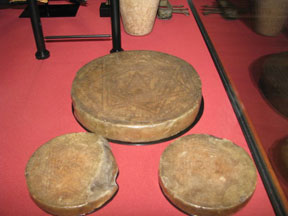
Three of John Dee's Sigillum Dei Aemeth's in the British Museum. Why does Dee use y/14 instead of y/15 on the perimeter?
This is indeed a puzzle. Would someone as seemingly obsessed by detail as Dee have made an error so critical, in terms of how he himself approached things? Above, Holden also alludes to the extremely important connection to the concept of a Golem: in legend, Rabbi Loew's Golem had emet [or aemeth] on its forehead when life—air [aleph]—was breathed into it, but when the aleph was taken away, and the Golem had only met or meth [mem, tau] left, it died. It looks like Dee has left the perimeter of his Seal "dead," unless we can explain it another way.
Such an explanation is simpler than one might imagine: the letters around the perimeter have no apparent use as "stand-alone" squares in terms of the rest of the talisman. They're used to derive godnames;[14] y/15 is only needed correct to generate other names, not as a talisman itself. Dee is told how to derive particular names from the perimeter, and the y/15 number would affect those names, were it used. (One might want to check and see if it is indeed actually so used. If it's not, that makes the situation even stranger.)
The perimeter letters have another supposed use dating from 300 years later, that of MacGregor Mathers, who through a laborious process the logic of which remains unexplained, derived from these perimeter numbers the names of four Enochian Kings and attributes them to particular Tablets.[15]
So we have another possibility, besides Dee falling for his own blind: that Dee, understanding that these letters and numbers did not affect the use of the Seal as a talisman, but were for something else entirely, introduced the blind onto his own Seal, taking the odd reception of this square as an archangelic hint at its importance.
Now, it happens that this blind can be located and solved all in the same place, and only affects one component (unless one considers the names Mathers derives from it, which we're not doing right now since they aren't in the original system.) What happens when one part of Dee and Kelley's system interfaces with or is part of another, and those "parts" contradict? That's exactly the situation we find with the Angelic Governors, their Seals, and the Great Table of Earth.
The 91 (or 92 or 93) Angelic Governors, their Spatial Relationships, and a "New" Rectified Great Table
After receiving the Enochian (or Ophanic or Angelic) letters and Sigillum Dei Aemeth, Dee describes and draws out other components, including the Holy Table, Tablet of Nalvage, protective lamens, and a ring. Then, April 14-May 14 1584, Edward Kelley scries the first 14 Angelic Calls or Keys, material that makes up over a quarter of Casaabon's True and Faithful Relation. After that, Kelley scries 91[16] Angelic Governors, on May 21-22 1584. The next day, the 91 provinces ruled by the governors are communicated; we will not address those at this time, because these names (whatever one decides they are, or what part of the earth one maps them to) do not directly affect how the Governor Seals map to the Great Table. Instead, they are supposed to show what parts of the earth each Governor "governs." [17]
June 20, 1584, Edward Kelley has his vision of four Gigantic Watchtowers. The so-called "Golden Talisman" showing this Vision can still be seen in the British Museum, though a close study of this talisman will show that it really corresponds more to a drawing of Causabon's A True and Faithful Relation than to Dee's original manuscripts, and thus may really date from the next century.
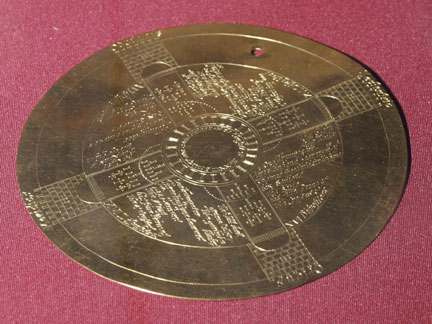
The "Golden Talisman" in the British Museum, courtesy of john007dee.com.
A complete description of Kelley's vision as transcribed by Dee is available on-line or in many published works.[18] The contents or occupants of the Watchtower are usually mapped to the four quadrants of the Great Table of Earth (though note that the Great Table has not yet been received.) These include 4 Trumpeters, 12 Banners, 24 Seniors, 4 Kings, 20 Princes, and 16 Crosses, each with 4 angles and 10 faces. These names generated from the Great Table are "mapped back" to Kelley's vision and forward to other material.
David Hulse points out—and this will become key, all puns intended—that when mapped to the Great Table, the above mainly form "linear God names,"[19] while the Governor Seals in almost all cases are not linear but jagged lines. The Governors govern the Great Table; the subsequent names are derived from the Great Table, based on whatever letters one places in each square of the grid. How one derives those names is also available in many printed and on-line works.[20] However, determining these names depends totally upon having the squares of the Great Table lettered correctly, something every in-print commentator the authors are aware of say that Dee and Kelley were unable to do.
Just a few days later, June 25, 1584, the four Watchtowers as four 12 x 13 gridded table are communicated. They are made up of the names of the Governors, in a totally different order, with seemingly random capital letters.
Studying the sheer complexity of how the Governors interlock with the Watchtowers is enough to convince anyone who studies it deeply that the material—wherever it came from—can't be a hoax.[21] The real question--if one postulates that some higher intelligence, be it Angelic or mathematical or something else, governs the structure of this material--is how to letter the quadrants or Watchtowers of that Great Table. All of the names derived from them depend on the relations of particular letters to each other on the Table.
Attempts to rectify the Table with the Angelic Governors which appear on it but are often not corrected, creates a confusion that most think Dee and Kelley never solved. Through 1587, Dee and Kelley together and separately appear to search for solutions to this problem.[22]
The authors think that Dee and Kelley likely did solve the blind, but simply did not write out the solution so others could read it. After all, if Dee inscribes a blind into his own Sigillum Dei Aemeth, how likely is he to write out a solution for how to mesh the Angelic Governor names with those of the Tables? We don't think he would.
By working through Dee's own 1587 drawings that precede the Invocations to the Good Angels (Fundamentalis ad DEUM Supplicatio et Obtestatio pro Angelorum Bonorum, benigno, habendo Ministerio)in Sloane ms. 3191, we can start to see the outline of how Dee envisions the Watchtowers are oriented in space.[23] Once correctly oriented, and the "blind" of the Governors solved, we'll be able to see and solve another "problem," that of the 65th Governor, presented in all reversed capitals as PARAOAN,[24] and how the "adverse" letters on the edge of the Great Table wind up connecting to the central Black Cross that binds the whole Great Table of Earth together.
First, let's look at how to solve the blind of the Governors and mislettered squares. The solution can be expressed easily, though the proof of it is rather excruciating.
Simply put, Governors by definition govern the Great Table of Earth. . . so, a correction to a Governor always trumps a correction to a letter, because the Governors govern the letters. No matter how many corrections to individual letters are made, the same principle holds: a correction to a Governor changes the letter on the Table, but a correction to a letter never changes the name of a Governor if Dee and Kelley have already been told that Governor is correct. If a letter is changed on the Table, but it has not been changed in the Governor, that change is a blind or a "miscommunication," and thus should not really be changed. Using this principle alone, it is easy to "rectify" the tablets. Dee's constant questioning of the angels, and their refusal to answer or their giving of answers that appear nonsensical, simply calls attention to this blind, much as the oddness surrounding the reception of perimeter square y/15 in the Sigillum Dei Aemeth also is a way of saying: pay attention! There is a principle here that must be understood before proceeding!
The angels dwelling on the name PARAOAN on July 2, 1584, and telling Dee and Kelley that every letter of it is living fire, and the N a vial of destruction, similarly says, pay attention! When we see something seems "odd" concerning PARAOAN (for instance, that this Governor has no Seal associated with it and is made up of reversed capital letters), we can assume that this "oddity" will be part of an important blind that Dee will not solve for us. He will call attention to it, but not solve it and leave the solution behind for anyone to read. In effect, he will use the same "teaching technique" for others that the angels used with him.
Remember the incredible information John Dee was told this Great Table contains—among other things, he and Kelley are told it contains the secret of all knowledge. We might imagine Dee thinking that anyone later who used the material should at least be able to figure out these blinds, if they are worthy of using such a powerful tool ! It has become a too-frequent assumption that John Dee and Edward Kelley never used this material, but the very presence of Sloane ms. 3191 as a carefully prepared book on ceremonial magic challenges that assumption. (In fact, Dee even records that there will be a time later when this information should be revealed, just not when this will be.[25] For all we know, it could have been the next month. The record of daily spirit communications breaks off not long after this.)
In the case of the Sigillum Dei Aemeth, Dee understood the reason for oddly communicated information fairly quickly, and turned that understanding into a blind on his own Seal. In the case of the Governors, it took him much longer to figure out the solution. The time period where he would have the solution corresponds, interestingly enough, to the time period Edward Fenton declared was "the most sensational part"[26] of Dee's spirit diaries, a time which included John and Jane Dee and Joan and Edward Kelley signing a pact to "share all in union," and apparently proceeding over the next year to swap sexual partners repeatedly.[27] It followed only by a few months Kelley giving a "public demonstration of the philosopher's stone" for Edward and Francis Garland. Francis Garland seems to remain around, sporadically at least, through spring 1587.
Dee's spirit diaries as preserved in the Cotton manuscripts break off near the end of spring 1587 with a couple of odd letters from an unidentified courier "Gulielmus."[28] Meanwhile, a separate set of manuscripts from an overlapping time period, preserved as Sloane ms. 3191, show Dee carefully writing out all sorts of correspondences, as if he is preparing a teaching manual for the most advanced components of his Angelic materials, which include the Keys, the Great Table, the Governors as they interact and interface with the Great Table, and the Angels of the Tabula Bonorum,[29]among others. It is clearly a book of ceremonial magic, as opposed to a record of particular magickal sessions, and while it makes use of material dated as early as 1584, it seems to have been written out in 1587, in the midst of the dramas described above, and the year before the Spanish Armada sailed towards England. Thus the context in which this book was written is fantastic beyond most of our wildest imaginations.[30]
We'll recreate here only the parts of the process which show how the Governors interface with the Great Table, and which will affect our later discussions of the Black Cross/Tablet of Union, and help begin a discussion of directional, elemental, alchemical, and temporal attributions. By the end of this first sub-section, we'll present a rectified Great Table.
Okay. Let us, finally, begin.
Dee's tabling out of the 91 Governors is recorded in Sloane ms. 3191 as his Liber Scientiae Auxilii et Victoriae Terretris, or The Book of Knowledge, Aid, and Earthly Victory. An excellent listing appears in Hulse's Key to the Western Mysteries.[31] (Many of the earlier listings of the Governors have multiple errors, chiefly but not exclusively because the Governor names have been changed by the letters in the "Tabula Recensa.") The original Liber Scientiae may be viewed online as well, courtesy of the Magickal Review. Checking Dee's table shows that the capital letters on the four quadrants of the Great Table are all the first names of the Governors (with the exception of eight adverse letters which we'll discuss later).[32]
Each Governor is given listed with its Seal.[33] For a complete list, please see the appendix to this article. We'll just list the first three to give you a visual idea:
| 1. | Occodon |  |
| 2. | Pascomb |
|
| 3. | Valgars |
|
After Kelley scried, and Dee recorded, all 91 of these, back in May 1584 in Cracow, Kelley had his spectacular vision of the Watchtower described above. Note that in this vision, Kelley describes something round. Yet its components are thought (by Dee, Kelley, and every writer we are aware of who has considered the topic since) to map to particular parts of the Great Table, which appears square.[34] Knowing Dee's life-long fascination with ancient Greek geometry, one suspects Dee would attempt to reconcile this dilemma with his geometric notions of how one might square the circle, or render it three-dimensionally with how one might cube a sphere.[35]
Dee and Kelley are instructed how to map each of these Governor Sigils onto a grid (with four exceptions: the 28th-30th governors, Lexarph, Comanan, Tabitom, and the 65th governor, PARAOAN, do not have Sigils). The name given for the 65th governor, PARAOAN, is really a blind; in fact the Sigil we might give it corresponds to the letters Laxdizi.[36] If one looks at Liber Scientiae, one can see that he leaves a blank space where the Seal PARAOAN should be; in the drawings that precede the Invocations in Sloane 3191, Dee has an extra Seal or Sigil and it corresponds to the letters "Laxdizi," not "PARAOAN."[37]
Before further looking at Dee's table of Governors in Liber Scientiae, let's take a look at the five curious drawings connected to the Great Table which occur in Sloane ms. 3191 folios 52b-58a, just before the Invocations to the Angels of the Tabula Bonorum. They also immediately follow a drawing of the Angels of the Tabula Bonorum, yet most would not find any particular connection between the Angels of the Tabula Bonorum and the Great Table or the Angelic Governors.[38] You may want to view these on-line here before reading further.[39]
These drawings, like the rest of Sloane ms. 3191, are clearly not immediately transcribed Angelic material, but Dee working out previously received information, as can be noted by the neatness of the drawings and the calligraphic writing which follows it in the Invocations. That makes the slight corrections made on some of the Great Table drawings, and mirrored in the equally detailed and calligraphed tables in Liber Scientiae, even more notable than usual.
We'll go through these drawings one at a time. First, Dee draws out a grid:
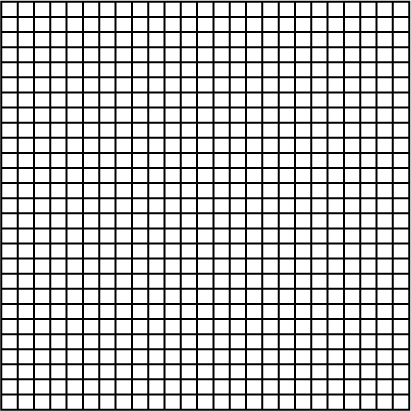
Then, Dee draws a second set of tables where he writes Romanized equivalents of Enochian letters into the grid. That's the Table usually called the "Tabula Recensa," as illustrated in our discussion last issue.[40] Sometimes it's called the "Raphael Recension."
If one looks closely at this first Great Table, it seems at first to not correspond to the surrounding drawings in Sloane ms. 3191. The tables are also re-ordered from the first reception in 1584.
Since directional and elements attributions are not clear at this point, we'll refer to each Watchtower (each quadrant of the Great Table) by using Roman letters for the three godnames that run across its meridian: oro ibAh aospi / oro ibAh aozpi, [the modern East/Air Tablet]; mph arsl gaich / mph arsl gaiol [the modern West/Water Tablet]; MOr dial hCtGa [the modern Earth/North Tablet]; and oiP tea pDoce [the modern Fire/South Tablet.]. Notice that at this point we're using two spellings for two of these names. We'll explain by the end of this section.
This second set, the first of two lettered Great Tables in this sequence of five drawings, contains quadrants in this order, and godnames spelled thus:
| oro ibAh aozpi | mph arsl gaiol |
| MOr dial hCtGa | oiP tea pDoce |
If we made modern elemental and directional attributions (see above) we would also have the correspondences modern occultists from Wiccans to neo-pagans use for the lower four points of the pentagram. But as stated, no directional and elements attributions are clear, or at least explicit, at this point.
Outside of each quadrant, you'll see the Seal or Sigil still associated with that quadrant. As the quadrants shift in later drawings, notice that the Seals shift with them or disappear, but never appear with a different quadrant of letters: for instance, the capital "T" with four squiggles always stays associated with the quadrant that contains "oro ibAh aospi / oro ibAh aozpi;" the one that looks like a little sun always stays next to "oiP tea pDoce." You'll also see, in the Black Cross that holds these names together, the names most now associate with the Tablet of Union. Here, these names are never tabled out into a 4x5 grid of their own (as is modern practice, and as Dee did in June of 1584), but appear in the Black Cross that binds the other four quadrants together.
If you shift to the next set of Tables, you'll see the Governor Seals / Sigils / jagged lines drawn onto four more tables. They appear thus:
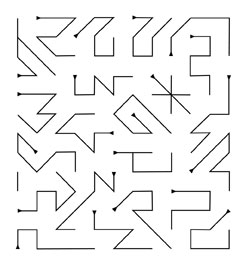 |
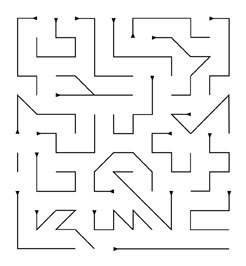 |
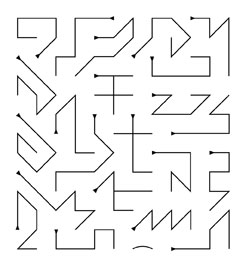 |
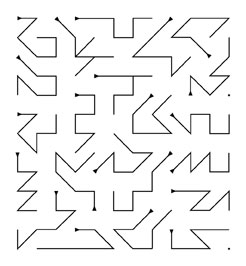 |
If you compare the Seals or Sigils to the preceding, you'll see that the quadrants are now in this special arrangement, but numbered outside of the tables in this order:
|
|
|
|
The spatial relationship corresponds to the original order in which they were received; the numbering 1-2-3-4 corresponds to the "Tabula Recensa" discussed last issue, assuming you start at the upper left and go around clock-wise.
If you go to the effort of determining what Governors each of the jagged lines correspond to, you'll find that they map by shape to the Governors in our appendix with one exception which will be discussed below.
The only quadrant in the same place is the first, the one we've labeled "oro ibAh aozpi," now usually associated with the East. However, if you follow the sequence of the first or "Tabula Recensa" group, starting with "oro ibAh aozpi," and go clockwise around the quadrants, you'll get the same sequence that you would get if you follow the numbered versions above:
- oro ibAh aozpi
- mph arsl gaiol
- MOr dial hCtGa
- oiP tea pDoce
(Notice that this also suggests the sequence of names used by modern esotericists for the Tablet of Union, which by Sloane ms. 3191 no longer appears. We'll discuss this further in the next section.)
After the third Table, that above which shows the Governor sigils, Dee presents yet another Table with letters. The lettered quadrants now match the spatial relationship of the Governors above, are numbered in the same way as the Table of Governors above, and now the Seal or Sigils from the first group of tables have been moved to match the corresponding tablet. On the original manuscript, in the upper right hand corner, you can still see Dee's marginal note that says "so they must be placed," and gives letters that suggest the first letters of the quadrants as ordered in the "Tabula Recensa;" that is, r/T above, b/d below. In other words, he's made the drawing out of order and put in a marginal note to reorder it.
These Great Tables seem, to us, to show Dee looking at the four Watchtowers and either trying to figure out some sort of principle explaining their order in space in relation to one another, or, more likely, creating a teaching tool to show this to some other person or group.[41] Dee makes it almost impossible for anyone to make directional attributions that make sense unless that person first comprehends the deeper structure. And in fact, he has been writing for himself, and perhaps others, subtle directions showing the logic he has applied: he has presented first the new "Tabula Recensa" order, then shown the Governors in an older order that made sense to him, [42] adjusted letters to match the Governors but done so with multiple corrections and a marginal note to go back to the order of the first lettered drawing (the second in the sequence) which has the fewest multi-lettered squares. Thus drawings three and four show the process he has gone through to come up with drawing two. This alone shows that Dee considered that the Governors ruled the placement of the quadrants themselves, implies that they should govern placement of individual letters, and shows he considers the material important enough that he will only convey it indirectly. As with his Sigillum, if someone just copies the material without understanding the built-in blinds, they will have material with errors: in this case, incorrect or multi-lettered squares.
The next drawing is the most confusing of the group, and one we'll return to and discuss briefly near the end of this article and in detail next issue, for it will be a key in understanding how Dee projects the Great Table of Earth upon the celestial sphere and how he may even connect it to his belief in a coming Golden Age. Dee presents this graphic just before beginning his Invocations:
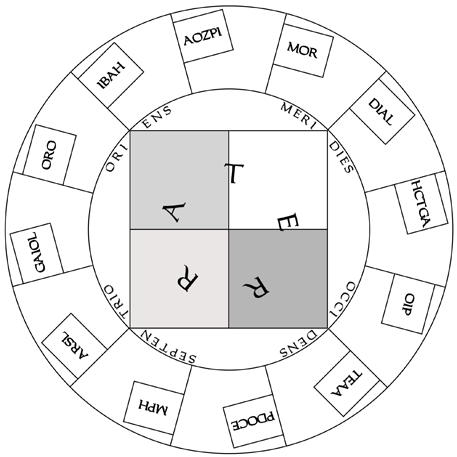
He's arranged the letters for "TERRA" (Earth) in a pentagram on top of four squares which logically, given their placement after the preceding four sets of tables, represent the four quadrants of the Great Table of Earth.[43] If the circle around the square is indeed Earth and the quadrants are the Great Table of Earth, then it appears the Black Cross runs directly through the center of Earth.
Now, the names that have been the middle of the four quadrants are presented as banners running around the outside between two circles, while the larger square in the center is inscribed in the inner circle, and what appear to be directional attributions are given to each of the tablets:
- ORO IBAH AOZPI – ORIENS (Latin for "the East")
MOR DIAL HCTGA – MERIDIE (Often Latin for midday or noon; here most logically "the South."
OIP TEAA PODCE- OCCIDENS (Latin for "the West")
MPH ARSL GAIOL – SEPTENTRIO (Latin for the seven stars near the North Pole; here most logically "the North.")
These names and the Watchtowers they appear on clearly don't match modern attributions, again except for the very first one, ORO IBAH AOZPI, which now as then is usually associated with the Watchtower in the East.
Indeed, the lack of surface correspondence to surrounding material or to modern correspondences may be why many most recent writers (Tyson being the notable exception[44]) either ignore this drawing or simply say it is wrong.[45] Yet one can find a similar set of Oriens-Meridie-Occidens-Septentrio attributions on the British Museum's above-pictured "Golden Talisman," derived from Kelley's 1584 Vision of the Watchtower, and as one of the drawings in Meric Causabon's A True and Faithful Relation...,[46] a 1659 transcription of manuscript Cotton Appendix XLVI.
But both the words Dee uses for north and south and the drawing itself suggest that what Dee is really thinking of here is not a square in a circle inside another circle, but a spinning sphere (like the Earth) with a cube inscribed within it, and that cube/sphere surrounded by another sphere. The Latin words meridie and septentrio do not correspond directly to our notion of north and south as compass points. Meridie, which usually means noon or mid-day, can also mean something akin to "south of here," towards the "middle" (or towards what becomes the "Equator," even though we now use "prime meridian" to mark off eastern and western hemispheres rather than northern and southern ones.) Septentrio (and the related adjective septentrĭōnālis), was regularly used to refer to the northern winds, or the north as a quarter of the heavens, and was associated with the seven stars near the North Pole.)[47]
If Dee is conceptualizing a cube in a spinning sphere like our globe, then "east" and "west" really only have meaning as directions of spin around a pole. The other two directions become polar points, polar north and polar south. Keep in mind that Dee, like all of us, must try to make sense of new information in terms of what he already knows, including the mysteries he has spent a lifetime exploring. His Propaedeumata Aphoristica, a 120 Theorem expansion of the Monas Hieroglyphica or Hieroglyphic Monad, implied that the "preliminary teachings" everyone needed to know was "something" (no one in print has explained exactly what) that involves how spheres in the heavens exert force upon both an individual and upon the Earth, and gives directions on everything from capturing that energy for making talismans and locating oneself on earth in relation to the cosmos.[48] As early as the third theorem of the Monad, Dee makes it clear that his two-dimensional circle implies a sphere.[49]
To Dee these four squares in a circle which implies a sphere likely define the sides of a cube. The Black Cross, whatever it is, runs through the center of cube in a spinning sphere. If one reduces it back to two dimensions (four squares on a plane with two lines that intersect as a cross), the two lines easily become four by being displaced from the single intersecting point, an idea presented by Dee as a key point in the Hieroglyphic Monad in Theorem VII.[50]
In his sacred geometry work Dee (like virtually every geometer of his time) was concerned with the three classical problems of sacred geometry, one of which was the squaring of the circle; in addition, as Wilson has demonstrated, he's already stumbled onto a concept of higher dimensions via his attempt to use conic sections to solve the Delian problem, or the doubling of the cube.[51] Dee must bring his previous understandings of sacred geometry to this drawing, and, as with the monad glyph itself, presents his understanding in a typically condensed and opaque format. This drawing, unlike the preceding ones, appears to be totally Dee's construction of how he thinks the material goes together. The only preliminary referents that are anything close are his transformations in the Monad, first, and Kelley's Vision of the Watchtowers, second. It is referred to nowhere in any of the angelic conversations; he is nowhere told to make a drawing anything like it. The reader's time would be well spent in studying how the Monad glyph might relate to this much-ignored diagram and how that understanding might inform diagrams of Kelley's vision.
We'll put that drawing aside for now, at least until the next section. We now have four Tables and an unusual square in a circle in a circle. Together they show Dee looking for (or perhaps, finding and illustrating) some principle of how the four quadrants of the Great Table are arranged in space and in relation to one another, and always keeping the same Governor Seals with the same quadrant and same Watchtower Seal with the same quadrant.
Both the table in Liber Scientiae and the five drawings which preceded the Invocations show Dee trying to reconcile discrepancies between individual letters, and entire Governor names. For instance, consider the drawings below. We have intentionally focused on one of the Governor names, Virochi, which affects one of the Godnames often used by modern occultists, one of the three that runs along the meridian of the Watchtower today associated with Water/West, which appeared in Dee's drawing above associated with the North, which Dee's drawings always appear to spell "mph arsl gaiol."
Governor #8, Virochi, runs through some of the squares in this series of Godnames, as you can see in the first drawing below. We've highlighted the Governor Seal in Blue, and circled the letters where there is a discrepancy. You can see Dee left the "ol" in, but also wrote in below "ch," which is what the Governor name would be. Unlike the example in the lower left, where Dee has stricken out an earlier letter and written in a correction, here with gaiol/giach, he has left both.
As a contrast, if you look at the fourth Table in the group discussed above, you will see multiple places where Dee has crossed out one letter and replaced it with another. Here, with this example and a few others in Liber Scientiae and this Table preceding Invocations, he has left in both.
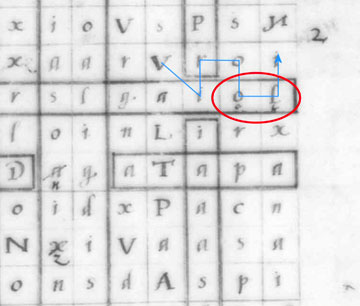
Caption: Extract from Sloane ms. 3191 Invocations, f. r7, copyright British Library, used with permission.
Let's look at the same Governor where it appears in Liber Scientiae. Here Dee has done the reverse: He has written out the name of the Governor, Virochi, and under the "ch" written in an "ol," using the numbers from the "mph arsl gaiol" god names.
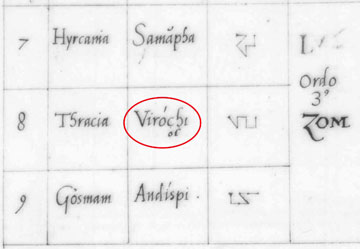
Extract from Sloane ms. 3191 Liber Scientiae f. 17, copyright British Library, used with permission.
Hulse, who gets further in his in-print explanation of this than anyone else, notes that these and other discrepancies between letters in the Table and letters of the Governors "created a great dilemma for Dee, causing the creation of the multi-lettered squares in the Watchtower system."[52]
Rather than suggesting that Dee could never make up his mind, we suggest these two sets of drawings in Sloane 3191 show Dee placing in plain sight the solution for the blind: if we understand that the Governors govern the Table and the individual letters do not, then it is easy to know which letter to pick: the one that corresponds to the Governor. Thus we should have "mph arsl gaich" and "oro ibAh aospi" rather than what he has on the drawing which follows. That next drawing is to illustrate how the Table of Earth maps to a spinning sphere, not to solve the blind of the Governors.
To rectify the Great Table after the Tabula Recensa, first return the quadrants to the order of the Tabula Recensa, keeping the Governor Sigils and the Watchtower Sigils with the quadrants they correspond to.
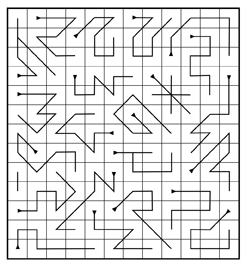 |
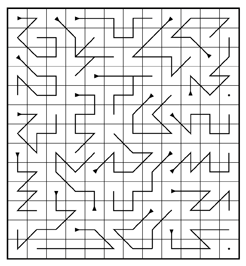 |
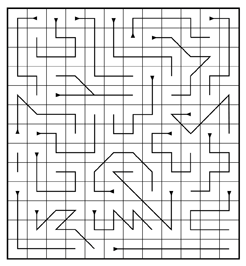 |
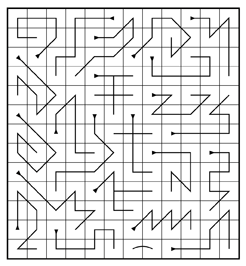 |
If you add in the letters that the Governors connect, you see something that starts to look more like the the Great Table. Also, notice which letters are not part of a Governor. We now have this:
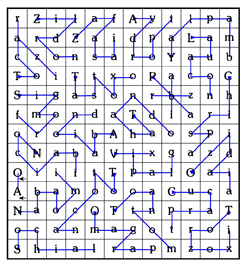 |
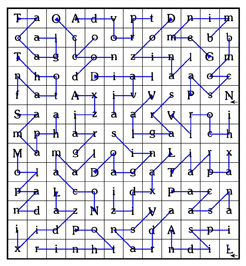 |
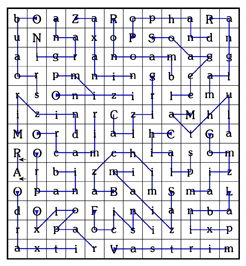 |
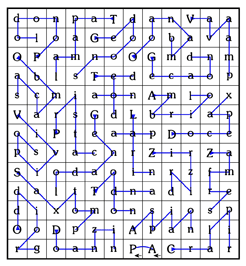 |
If you put in the Black Cross (as Dee did in all of the drawings described above), you would have a Great Table of Earth that, with the Blind of the Governors solved, would look like this:
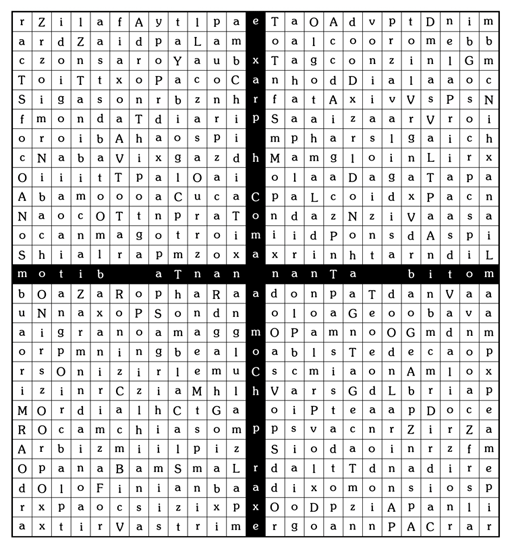
If you add the shadings that make it easier to determine the linear godnames now derived from the Great Table, you have this:
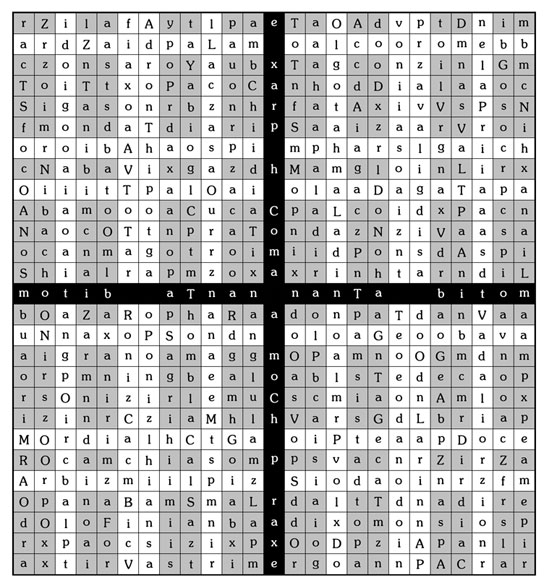
With the Great Table arranged this way, we start to see other things not as easily apparent on Dee's originals. We will find that there are 88 Seals, not 87 as in Dee's list. The three in the Black Cross—Lexarph, Comanan, and Tabitom—don't have Seals (the jagged lines that connect letters in the Watchtowers), but there is one extra Governor: if we look at the "mph arsl gaich" Watchtower, we'll see a set of jerky lines which connect the letters "Laxdizi." Logically then, we can substitute "Laxdizi" for Paraoan. It is via this argument that Hulse argues that PARAOAN, composed of all capital letters and seven of the eight "adverse" or reversed letters is "the invisible Governor ruling the visible 91," or the hidden 92nd Governor.[53] Bridges agrees and suggests that this might be rephrased as the Governor that "underpins" or supports the other 91.[54]
How might that be? Take Hulse's argument a step further, and you'll see that the eight reversed letters, PARAOAN and L, connect the "outside" of the Great Table to the "inside," once the four quadrants are conceived as the faces of a cube placed in four directions and held together by a Tablet of Union/Black Cross. We'll explain that in our next section. If PARAOAN is indeed "invisible," on the surface of the Earth (those spaces which the other Governors govern), the "place" where it likely resides is that hyperspace where the "outside" of the Watchtowers connects to the "inside" of the Black Cross. If one prefers a three dimensional conception, think of it this way: if we have 91 Angelic Governors that govern parts of the surface of the Earth, PARAOAN governs what is under the surface of the Earth. The 93rd Governor postulated[54] by some will not be explained this article.
In the meantime, the reader is invited to derive the remaining linear godnames on her own! Once the Great Table is lettered correctly, that exercise is a relatively easy one explained in multiple places, on-line and in print.
The Black Cross/Tablet of Union: the Outside becomes the Inside
As discussed, the three Governors that don't have Seals, Lexarph, Comanan, and Tabitom, make up the Black Cross. In modern Enochian / Ophanic magic, the Black Cross is often represented as the Tablet of Union. As noted above, if you use the "Tabula Recensa" order, start in the upper-left and go clockwise, you get these four groups of godnames on the meridians:
- oro ibAh aospi
- mph arsl gaich
- MOr dial hCtGa
- oiP tea pDoce
As most readers know, modern magicians refer these names to those four Watchtowers: oro ibAh aospi/EXARP; mph arsl gaich/HCOMA; MOr dial hCtGa/NANTA; oiP tea pDoce/BITOM. If we were to use this modern Table but add back the L and capitalize the first letter of Governors as Dee does elsewhere, we'd get something like this:
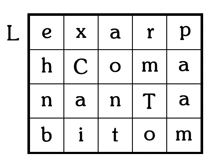
Where does the modern Tablet of Union come from?
Very early in Dee's angelic working (June 26, 1584) is the only place where we find anything remotely like it and even then it is not at all that clear that Ave, Dee, or anyone else intends these words to be used as a standing component in ritual. In fact, it appears to us that this is an error Dee makes, goes back and corrects in the same manuscript, and never presents in the same way again. By the time he tables out the Governors in Sloane 3191 and presents the five drawings discussed earlier in this essay, he uses a Black Cross, not a Tablet of Union. He actually starts to do that the same day he first receives the information.
We'll take you through the whole process in a moment. It's one of the few places where we see Dee, "on stage" so to speak, grappling with something truly at the edge of his mathematical understanding. If Robert Wilson's analysis of Theorem XX of the Hieroglyphic Monad is correct (that is, if Dee understands his connection or ability to navigate in dimensions above three as an apocalyptic connection to New Jerusalem, among other things, as demonstrated by his ability to use an unusual application of conic sections to solve the ancient sacred geometry problem of the Doubling of the Cube and thus find connections between seemingly non-adjacent spaces,[56]) it is no wonder he considered this material so valuable. He would have, in terms of his ability to understand it, been "seeing" proof of what he had written about so many years before. He would also see it as "proof" of the Hermetic maxim as above, so below; as within, so without.
Today, we might describe this in terms of how four- and five-dimensional spaces, or four dimensional spaces with time as an added dimension of energy flow, allow information and energy to transfer in ways that make no sense in three dimensions.[57] But to Dee, it would have been a demonstration of the Divine and proof of Hermetic concepts in action.
To make things even more dramatic, Dee receives this "proof" immediately after Ave describes what the Great Table contains, the previously discussed list of nine items which begins with "all human knowledge." The proof, which it takes Dee some time to assemble and rework into the drawings he presents in Sloane ms. 3191, involves the four Governors that have no Seal and thus appear to not map to the Great Table: Lexarph, Comanan, Tabitom, and Paraoan.
Let's start in June 1584, and compare two accounts: that in Dee's semi-legible original manuscript, preserved as MS. Cotton Appendix XLVI, and Meric Casaubon's 1659 transcription of the same material, in A True and Faithful Relation. As the editors of the Magickal Review note in their on-line presentation of this material, Casaubon's work contains "numerous errors of transcription and of printing (too numerous to note), and the Cotton MS. itself is incomplete; however, Casaubon's text serves as an often invaluable aid in the reading of the MS., supplying the occasional word which has decayed since 1659, and otherwise greatly assisting in the reading of Dee's handwriting, which frequently borders on the illegible."[58]
If one reads over either Dee's original manuscript (which as noted is exceedingly difficult to do, as we're not now dealing with the carefully calligraphed writing of Sloane ms. 3191 but semi-legible rapidly written cursive) or Casaubon's transcription in A True and Faithful Relation, one sees that "Lexarph, Comanan, and Tabitom,[59]" when written out in this key section, actually are appearing as characters in the shewstone. In our discussion here, we'll rely on Casaubon except when it appears to us that his presentation distorts the material.
E.K. Now he [Ave] appeareth again.
. . . Look out Lexarph, with the two others that follow him, among the names of the Earth the three left.
Lexarph, Comanan, and Tabitom
Look out the name Paraoan. Write out Paraoan in a void paper.
Dee [written as Greek delta throughout]: I have done so.
Seek out Lexarph.
Dee: I have found it.
Look into the 4 parts of the Table, and take the letters that are of the least character. Look among the 4 parts that have the characters, and look to the characters that have the least letters.
Dee: I have done.
. . . How many letters are they?
Dee: Seven
. . .They must be eight.
Dee: They are these (as I have noted them) [illegible, conveniently]
. . .There are eight in the four. Dee: Afterwards I had found 8 letters in the 4 principles, for I had omitted [unclear in original manuscript; Causabon writes T l.]
. . .Dwellin darkness. Dee: I suspect this was spoken to me, to my reproof, for no more diligence used in the search.
Dee's original manuscript presents the material basically the same way. Notice that Dee seems to be looking at manuscripts he has already written out: Lexarph appears with two others that follow "him," but when Dee is told to seek out Lexarph, he says he has found "it," as if he is looking for the name on a manuscript.
One thing is much more apparent when one looks at the original: some of Dee's notes were likely written in later, such as the very final two comments above: he believes (later) that Ave has told him to dwell in darkness because he didn't find what Ave told him to look for (all eight letters), and having found them later, what Ave said makes sense.
That's critical when we look at the next section, the only place in all of Dee's manuscripts where something like a Tablet of Union appears. He writes the letters now used as the Tablet of Union out in a note to himself; yet material given him later the very same day show Dee learning how to put them in a "crosse of union or black crosse."[60] This time, Dee's original manuscript and Casaubon's transcription appear very different.
As you can see from the snippet reproduced from the original manuscript, Dee writes the four names now used in the Tablet of Union as a marginal note, with a line running from "Lexarph, Comanan, and Tabitom" to his note "these be 3 names of the 10th Aire. . ." , and an arrow up to the letters. It is not clear if the underlined "Lexarph, Comanan, and Tabitom" was written at the time, or squeezed in later as an after-note.
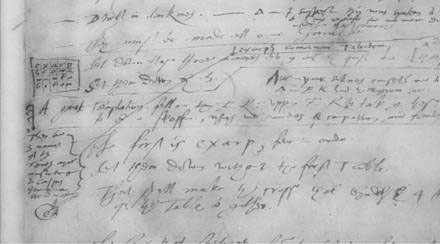
Dee's spiritual journal from June 26, 1584 as preserved in MS. Cotton Appendix XLVI. Copyright British Library; used with permission.
In True and Faithful Relation, Casaubon's transcription makes it look much more like this should be some sort of standing table, because he moves the marginal comment to the center of the page and rearranges many of the comments so they seem to more respond to each other. He presents the material thus, his rearrangement making it appear that Dee's marginal note is instructions by Ave[61]:
[Ave:] They must be made all one character.
e x a r p
h c o n [sic] a
n a n t a
b i t o mLexarph, Comanan, Tabitom
Set down these three names, leaving out the first L (that is of Lexarph, set them down by 5.)
When Ave says they must be made of one character, does that mean put them together in a table? Not if you look at the original manuscript, where the tabled letters are a marginal note. And in fact, as the session progresses, Dee is told to put these letters into a "Black Crosse" (described in the margins twice as "crosse of union or black crosse"[62]) in a way that matches what we see drawn out three years later in Sloane ms. 3191. Ave instructs Dee to place an "E" in the first square of the Black Cross, then gives some added material, about how a particular element might cure an incurable disease, and another has power over metals, and another than can give money coined in Gold and Silver. In other words, Ave seems to connect the Governors of the Black Cross and whatever they represent to the list of what the Great Table itself contains.
Never again after this do we see anything in Dee's writing like the modern Tablet of Union. Instead we see a Black Cross, which suggests multiple comparisons to Dee's use of the cross in earlier works like the Monad.
A slightly more recent manuscript, Sloane ms. 307 (perhaps composed less than a century after Dee's death) does show a Tablet of Union, but that could well be because those who used that manuscript were relying upon the transcription from Casaubon's True and Faithful Relation, which was published from material in the Cotton manuscripts, and did not contain material from Sloane ms. 3191, which as noted is a much more legible three-years later reworking of the material.[63] Or, perhaps, the writers of Sloane ms. 307 found the tabled-out letters easier to work with.
Let's see what happens if we move forward to Sloane ms. 3191, and look at Dee's reordered "Tabula Recensa" rectified as we suggested above. Once the Watchtowers are re-ordered as per another vision of Kelley's, something amazing appears that is not the case in the original order. ALL of the letters unused in making Governor sigils, which are also the "adverse" letters, now appear on the edge of the Great Table.
Remember Ave's 1584 instructions: "Look into the 4 parts of the Table [the Watchtowers], and take the letters that are of the least character. Look among the 4 parts that have the characters, and look to the characters that have the least letters." Ave's instructions apply to the Governor Sigils, not the letters themselves—all of the squares are filled with seven-letter Governor Sigils, except three Watchtowers that have a two-letter Sigil, and one that has two one-letter "dots." In 1584, Ave has told Dee to look for these characters, and he has written them out, though his writing is now illegible.
In the graphic below, we've circled the "adverse" letters":
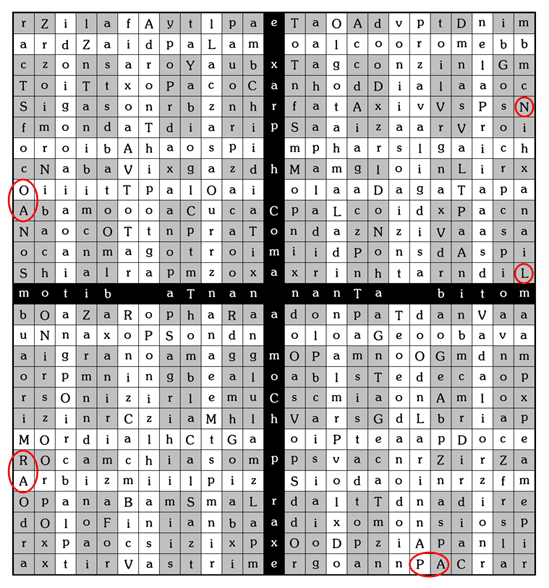
The adverse letters around the outside of the Great Table spell the hidden 92nd Governor, Paraoan, and the "L" of Lexarph, which may be the letter Dee omitted in the section discussed above. If it were, Dee would have no doubt connected his omission to Ave's comment that he dwelled in darkness, because years before, in the Hieroglyphic Monad, Dee makes repeated puns on L/El (Hebrew for God) and connects it to the central point of light from which all things come, the light that displaces the four "lines" of the cross, and which represents the LVX/INRI transformation which becomes the analysis of the keyword in modern Golden Dawn and Thelemic occultism.[64] The l, or linea recta, also becomes a key concept for a particularly elegant mathematical transformation involving parabolas and hyperbolas, concepts which grow out of the geometry of conic sections.
Most remarkably, though, we now see why Paraoan as a hidden 92nd Governor lies under the other 91: because the outside of this Great Table connects to the Black Cross on the inside. The "L"/"El"/ Dee's "God space" or "Christ-glue" from Theorem XX[65] starts on the outer edge of the Great Table and continues onto the Black Cross. And within the cross itself, we see concepts Dee would immediately see as "proofs" of Theorems XII, XVI, XVII and XX in the Monad[66]: in that work, he shifts a cross or X into 3D by viewing it as the result of two intersecting cones sharing the same axis and vertex being sliced through by an intersecting two-dimensional plane. In Theorem XVI he has told us he must stop and philosophize about the "cross," punning on Latin "crux," as in the crux of the matter, in this case how to focus the light of the Divine, then invites his reader to visualize a cross in terms of conic sections.[67] He proceeds to "slice" these sections into the letters L, V, and X in Theorem XVII, making LVX or the light of the Cross, and by XX, he presents two sets of intersecting cones (represented by the theorem's number, XX), which he uses for his proof of the Delian problem or the Doubling of the Cube, and in the process, runs into a concept we would generally associate with a hypercube rather than conic sections: the notion of edges that are separate in 3D touching each other in higher dimensions. (In fact, he also associates it with a cube superimposed over another cube; he just gets to that proof via conic sections.)
The non-adjacent edges that touch on the Great Table show the outside edge becoming the inside, and the inside circulating back out, as we might now conceive of a torus. We can now also speculate why the four five-letter names in the Black Cross appear twice, rather than once, unlike every other Governor name. They are a cube doubled. So, each of these names are written twice. They mirror each other, just as the "adverse" letters on the outer edge are "mirrors" of regular letters. Dee has truly, for better or worse, fallen through the looking glass, in trying to make sense of images scried by Edward Kelley.
Directional, Elemental, Temporal, and Alchemical Attributions of the Watchtowers. . . and their Colors!
Having fallen through the looking glass with John Dee and Edward Kelley, we can start to establish Directional, Elemental, Temporal, and Alchemical Attributions of the four Watchtowers that make up the Great Table of Earth. We speak of a "looking glass" only partially in jest, and partly as a concept one must understand to project the Great Table onto four directional faces of a cube, or onto the surface of a spinning sphere, like the Earth, or upon the celestial sphere, the night sky as viewed from a particular location at solstices and equinoxes. It will be key to realize how, for instance, a lens can reverse parts of an image, a concept Dee would be well aware of from his extensive work with optics. If one looks at a reflected image, two of the "directions" change, but the axis of symmetry remains the same. Similarly, in determining directions, we must determine what our point of references is: are we looking at directions that will work from a point on the surface of the earth, that work from the center of the earth, or from somewhere else?
We'll look at this in much more detail next issue, as we take up our one-issue-delayed discussion of modern adaptions of the Great Table, especially those of Moina and MacGregor Mathers and Aleister Crowley. We'll also see if there is a logic behind why the colors used by Kelley are changed into those use by the Matherses. On the surface, Kelley's colors appear to match those most frequently used by Kabbalists and Moina Mather's seem most influenced by late 19th century color scale theories used in art schools. Does her development of the four color scales relate at all to material her husband may have understood about other correspondences of the Watchtowers?
If you would like to try to work out these correspondences on your own in the meantime, here are some guiding principles to keep in mind: as stated above, notice how an image is reversed when you look into a lens; keep in mind also that compass points North-South-East-West are only relative directions. In June 1584, not long after the angelic conversation discussed above, John Dee does ask Ave about directions. He asks what is meant by working in the East, and is told "The East and West, in respect of your Poles."[68]
On the surface of a spinning sphere, east and west only really make sense as directions of spin and are most easily defined at the Equator. Polar north and Polar south define the tilt by which someone at the hypothetical center of the Earth—the center point of the Black Cross—might look up, or down, and "see" different objects in the sky. From this model, we can "map" the "Tabula Recensa" to the night sky, and find directional and elemental attributions that match those used by MacGregor Mathers. In fact, they match with such accuracy, and are elaborated upon by Mathers so well, that Mathers must have understood this part of the system.
Yet we can further demonstrate that he did not seem to have a concept of higher geometry nearly as well-developed as Dee's, nor an understanding of some of the blinds discussed in this article. As we search for the source of MacGregor Mathers' information in the Concourse of Forces, we'll be led once again through the legendary world of Secret Chiefs and second-hand bookstores, and run into the deepest mystery of them all: "elemental" attributions to the Watchtowers that appear to correspond to constellations ruled by the "fixed" signs in the zodiac, and which match best not in Dee's time period, but our own.
In the meantime, we'll leave you once again with our updated Watchtowers, version 2010.2:
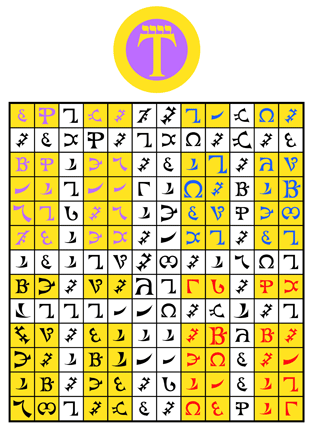 |
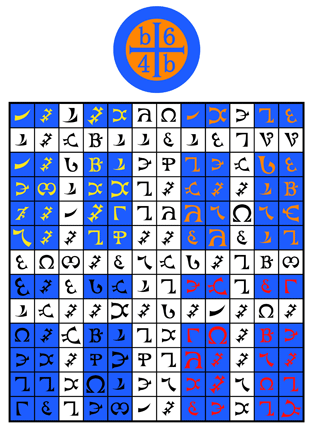 |
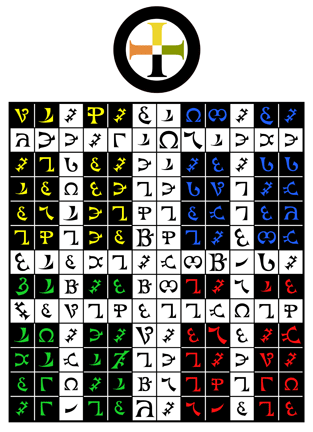 |
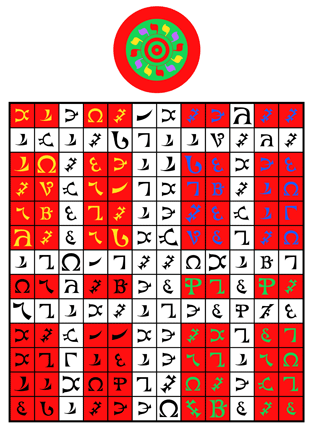 |
Notes
1. On June 26, 1584, via his scryer Kelley, Dee records the angel AVE telling him the "purpose" for these four Watchtowers: 1) All human knowledge. 2) Out of it springeth Physick. 3) The knowledge of the Elemental Creatures among you. How many kinds there are, and for what use they were created. Those that live in the air, by themselves. Those that live in the waters, by themselves. Those that live in the earth, by themselves. The property of fire—which is the secret life of all things. 4) The knowledge, finding, and use of Metals. The virtues of them. The congelations and virtues of Stones. They [these preceding three things] are all of one matter. 5) The conjoining and knitting together of Natures. The destruction of Nature, and of things that may perish. 6) Moving from place to place (as into this Country, of that Country at pleasure.] 7) The knowledge of all crafts Mechanical. 8) Transmutatio formalis, sed non essentialis [formal alchemical transmutation.] 9) [Dee's note in margin:] The ninth chapter may be added, and is of the secrets of men knowing, whereof there is a particular table. See further discussion: http://www.jwmt.org/v2n18/tablets.html
2. Ibid. Those we discussed specifically included the "Enochian" or "Angelicall" language itself, the Hieroglyphic Monad as a key to Dee's sacred geometry, and the Sigillum Dei Aemeth or Seal of Truth
3. This is in effect what David Hulse argues, though he makes the argument via pages of numeric analysis rather than by approaching it as a magical blind. See Hulse, The Key of It All Book II: The Western Mysteries, pp. 147-245.
4. Last issue, we said we would discuss, specifically, some aspects of the modern adaptations by the Golden Dawn, including Macgregor Mathers' odd system of determining the name of the Watchmen and other attributions which appear in his Concourse of Forces, and Aleister Crowley's adaption of some of these aspects in Liber Chanokh. Because that explanation is extremely long and this article is already complex and lengthy, we're deferring that discussion, which includes directional, temporal, alchemical, and elemental attributions of the Watchtowers and how it might connect to different systems of coloring and arranging those Watchtowers, until next issue. However, the first parts of these arguments are sketched out in this article's conclusion, in the event the reader wants to try to discover these correspondences on her own.
5. The intrigues around this working have been the subject of two previous articles by one of us: see Burns, Francis Garland, William Shakespeare, and John Dee's Green Language and William Shakespeare, Spy, and a Visit to Trebona. However, to our knowledge, no one has analyzed in print how or why the surrounding sexual "Action" connects to Dee and Kelley's other Angelic communications (if it does) or to physical alchemy (if it does) or to the about-to-commence Heptarchic working (if it does.) Note, however, that the manuscript we're chiefly discussing in this article (Sloane ms. 3191) falls in the same time period as all of these intrigues; notice also that part of the knowledge contained in the Great Table of Earth is "formal alchemical transmutation" (see note 1 above).
6. See the discussion of this in the related article this issue, in the sub-section 400 Years of Character-Assassinating Edward Kelley.
7. See Colin Campbell, The Magic Seal of Dr. John Dee: the Sigillum Dei Aemeth (York Beach, ME: Teitan Press, 2009), p. ix.
8. After Theorem XVIII, the "LVX/IRI" transformation we've discussed in an earlier Journal article, Dee struggles to continue his three dimensional Kabbalistic and Pythagorean correspondences because, as Wilson argues this issue, he has stumbled onto the concept of higher dimensions. Clay Holden further notes, and Don Milo DuQuette illustrates, that Dee's Monad glyph can be used, in its 4x9 grid, to produce a regular heptagon inscribed in a circle. See Clay Holden, "Forward," in Lon Milo Duquette's Enochian Vision Magick (San Francisco: Red Wheel/Weiser, 2008), xx; and Duquette in the same, 89. The way this glyph can be used to approach this problem from ancient Greek geometry approximates an earlier solution 1525 solution by Albrecht Dürer which Dee would have been well aware of. See Dürer, Underweysung der Messing mit dem Zirckel und Richtscheyt (Treatise on Mensuration with Compass and Ruler), 1525, or watch a modern animation online: http://demonstrations.wolfram.com/AlbrechtDurersHeptagonOf1525/
10. Thanks to Aaron Leitch for pointing this out.
11. This work is available now in many places on-line and in print; the most easily available are Joseph Peterson's John Dee's Five Books of Mystery (San Francisco: Red Wheel/Weiser, 2003), and on-line as part of Clay Holden's now-abandoned John Dee Publication Project: http://www.john-dee.org/Secundus.pdf. See the preceding URL or Peterson, pp. 102-103.
12. Holden, in DuQuette, op. cit., xix.
13. Peterson, op. cit., p. 42.
14. For a discussion of this see DuQuette, op. cit., pp. 56-64.
15. These names and attributions, which appear nowhere in Dee and Kelley's original writing, are: Air/ Tahaoeloj; Water/ Thahebyobeaatanun; Earth/Thahaaotahe; Fire/Ohooohaatan. Despite the extreme ill will between Mathers and Crowley (who battled each other in court), Crowley used the same names in Liber Chanokh. Did they understand something about the Seal that we do not? Did Mathers have access to some material since lost? Or is the attribution just silly? We'll return to that question when we get to later adaptions of the Enochian system next issue, but for those interested now: note that changing this numbering will also change the name of the Water King. The main people this "blind" effects are those who use the names of these Four Enochian Kings used by Mathers; they seem unrelated to the talismanic magic of the Seal itself.
16. As we'll discuss near the end of the article, some find a hidden 92nd Governor. Some also find a 93rd Governor, though we will not be discussing that in this article.
17. Many, many writers have grappled with this material. Some have attempted, using manuscripts of the time, to ascertain what parts of the globe Dee's odd geographic names referred to (for the best of these, see Robin Cousins, in Duquette, op. cit., Appendix III 212-213.) Yet one may read the manuscripts and notice that Dee simply doesn't have enough of a conception of global land masses to understand the information he is given: more than once, the "Angels" will point to a location on the spinning globe and there will be no word for it. Thus Dee's language reflects a hugely Eurocentric view, where European locales make up most of the Governors and other whole continents only have one Governor. This is not a criticism of Dee, who had one of the most sophisticated geographic educations of his age [see E.G.R. Taylor's Tudor and Geography, 1485-1583 (New York: Octagon Books, 1968, 1930) for several chapters on Dee's contribution.] But Dee did not have the vocabulary or knowledge to "map" this information. We suggest that a more correct mapping of these locations can only be done by understanding how the Great Table is oriented in space.
18. See http://www.john007dee.com/greatvision.html for a transcription; see David Jones's "The System of Enochian Magick, Part III: The Hierarchy of the Watchtowers," on-line at http://hermetic.com/enochia/system_enochian_magick_3.html for a teaching account; for an in-print discussion see Duquette op. cit. pp. 123-126 or Donald Tyson, Enochian Magic for Beginners (Woodbury, MN: Llewellyn, 1997) pp. 155-167); for a discussion of Biblical and other correspondences, see Aaron Leitch, "A Discourse on the Enochian Watchtowers," http://kheph777.tripod.com/art_discourse.html
20. See DuQuette, op. cit., or Tyson, op. cit., or Jones, op. cit., among many others.
21. In a note to students, David Jones writes: "The student of Enochian can compare the lists of names with the sigils, which formulate their existence on the Watchtowers, and easily see the correlation [between the Angelic Governors and the Watchtower letters.] But realize that the names were delivered first and then the Watchtowers horizontally line by line and after having both figures at hand. The Angels demonstrated that, by discrete (7 letters, the number of letters in each Governor's name) linear connections, all of the letters given in the Watchtowers could be accounted for from the letters that formulate names of the Governors previously given. This would require either a monumental and complex second and third order memorization (2 dimensions to 1 dimension then back to 2 dimensions and with directional correlation from a 3 dimensional origin to a 3 dimensional conclusion) on Kelly's part or an elaborate and extremely obtuse deception on Dee's part. This constitutes one of the chief proofs of the system." See: "The System of Enochian Magic Part II: The Evolution of the Tablets," available: http://hermetic.com/enochia/system_enochian_magick_2.html
22. The must succinct recounting all of their attempts to correct tablets is in Hulse, op. cit., pp. 180-184, 200.
23. See http://www.themagickalreview.org/enochian/mss/img/sloane_3191/3191_15_Invoc_f52b-58a.jpg. Of note, the drawing Dee makes of the Tabula Bonorum itself immediately precedes these drawings, and may be seen at: http://www.themagickalreview.org/enochian/mss/img/sloane_3191/3191_13_DHM-45b-51a.jpg
24. Because of the vagaries of HTML we are not able to render these letters reversed, but basically they should be one after the other in all capitals with each letter a mirror image of how it usually appears.
25. May 23, 1587, Dee records the following: "Green Woman: . . .Then shall your eyes be opened to see and understand all such things as have been written to you, and taught you from above. But beware ye take heed, that you dwell within yourselves, and keep the secrets of God, until the time come that you shall be bid SPEAK: for then shall the spirit of God be mighty upon you; so that it shall be said of you, "Lo were not these the sorcerers, and as such accounted vagabonds?" The easiest-to-read modern transcription of this section of the Cotton manuscripts is in Edward Fenton's John Dee's Diary, (Oxfordshire: Day Books, 1998) p. 226. Beware, however, that Fenton mixes different manuscripts of Dee's and material from Dee's personal and spirit diaries without saying which is which.
27. Since this is recorded in Dee's personal diary rather than his spirit diaries, we have a record of it.
28. Burns has elsewhere speculated that the "Francis Garland" in Dee's diaries may be none other than William Shakespeare, and indeed similarly speculates that this unidentified "Gulielmus" was the same person. See "Concerning Ed. Kelley's Poem" , "Francis Garland, William Shakespeare, and John Dee's Green Language," and "Shakespeare's Green Garland Part Two: William Shakespeare, Spy, and a Visit to Trebona," in previous issues of this Journal.
29. it is very difficult to make sense of Dee's drawing of the Tabula Bonorum until one has some kind of sense of how to orient the Great Table in space
30. See accompanying article by Burns, "A Golden Storm: Attempting to Recreate the Context of John Dee and Edward Kelley's Angelic Material."
31. Unlike most others, it does not contain a myriad of typos and inconsistencies introduced by using lettering from the Tabula Recensa rather than the Governors; thus it is that version, Causabon's version, and the Dee originals that we checked our appendix against.
32. For an explanation of the entire process Dee seemed to go through, see Hulse op. cit., pp. 183-184.
33. We consider these Seals or Sigils; some do not. We're following the argument of Hulse, op. cit., who throughout refers to them as Seals though he doesn't say why, and Vincent Bridges, who uses them as Seals for reasons not discussed in this article. For the purposes here, if you'd prefer to think of them as little jagged lines that run from square to square instead of Seals, that's fine!
34. The 12x13 grid make it actually slightly rectangular if one makes each one of the "boxes" in the grid square.
35. A formal mathematical discussion is far beyond the scope of this article, though one is welcome to apply the ideas discussed by Wilson, op.cit., to our more right-brain application of the ideas at the end of this paper.
36. The first writer we're aware of who makes this observation in print in Hulse, op. cit., pp. 195, 200. Oddly, DuQuette's more recent Enochian Vision Magic, op. cit., side steps the entire topic as if he is not aware of it or does not notice the existence of a Governor that maps to the letters Laxdizi instead of PARAOAN. Other recent accounts focus more on the letters and language and thus never discuss the Governors in any detail.
38. If one wanted to look for a connection, it's advanced far beyond the scope of this article. For instance, Bridges has pointed out that the Calls are generated from a 7 x 7 pattern similar to that of the Tabula Bonorum (personal communication, 2010).
39. Digitized versions of all the British Library manuscripts discussed on this article are viewable on-line courtesy of the Magickal Review: see http://www.themagickalreview.org/enochian/mss/.
40. The graphic used last issue was courtesy Ian Rons, used with permission, and available here: http://www.themagickalreview.org/reviews/practical-angel-magic-update/
41. Other sources from the time period also suggest that Dee and Kelley were teaching or giving demonstrations to some sort of group. For instance, consider the critical debate about whether or not Dee actually wrote Tuba Veneris, translated by Burns and Turner in an earlier Journal article as The Little Book of Black Venus. The earliest surviving manuscript, which is not in Dee’s hand, appears to have been composed on the European continent in the 1580s; whether or not Dee came up with it (as we think he did), or someone very familiar with his angelic work, someone other than Dee copied it down. Tuba Veneris also shows a doubling of the cube concept similar to the one discussed in this article.
42. As we'll discuss next time, and as Jones has pointed out op. cit., Dee's original Watchtower order in the Great Table has a particular heliocentric logic, and he is still using that logic for the Governors here. After a vision of Kelley's not recounted in this article, he changes the order to that of the "Tabula Recensa;" his progression here thus shows him presenting new information or an ordering that at first does not make sense; presenting the Governors in the old order, illustrating the principle of the Governors staying with the Watchtowers they Govern, then introducing directional attributions in a very opaque manner. Once one sees how he makes directional attributions, these transformations show a teaching process; until one does, they simply appear confusing.
43. The notion of the pentagram as coming from or being implicit in Dee's Tablets is discussed in an accompanying article, in the section "The Underground Stream Surfaces."
44. See Tyson's fascinating discussion in Tyson, op. cit., 147-149. It puzzles the authors how Tyson is able to go from seemingly brilliant observations like this one to others which seem more in keeping with very superficial and fundamentalist notion of Christian apocalypse.
45. As we'll explain more when we talk about directional attributes next issue, these are only "wrong" in a limited case which happens to be the one most people use the most—mapping the quadrants to four directions, when one "imagines" one is standing on a flat earth and seeing each of four directions off to the sides, as if they are four sides of a cube rather than directions that map to a spinning sphere.
46. Casaubon, Meric, A True & Faithful Relation of What Passed for Many Yeers between Dr. John Dee and Some Spirits, graphic on unnumbered page preceding p. 1. Available: http://www.themagickalreview.org/enochian/tfr.php
47. See Lewis & Short Latin Dictionary; on-line at: http://perseus.uchicago.edu/Reference/LewisAndShort.html
48. For a discussion of how the work of Dee's was related to the optics and physics of the time, see J L Heilbron's introduction to Wayne Shumaker's translation of Dee's Propaedeumata aphoristica [John Dee on astronomy: Propaedeumata aphoristica (1558 and 1568), ed. and trans. by Shumaker, Berkeley : University of California Press, 1978). Unfortunately, this is the only English translation available and both the translation and introduction and it reflects a very outdated notion of Dee's mathematics and natural philosophy.
49. Burns and Moore, "The Hieroglyphic Monad of John Dee Theorems I-XVII: A Guide to the Outer Mysteries," available: http://www.jwmt.org/v2n13/sign.html
51 See accompanying article by Wilson, "The Delian Problem and Transcendence in Theorem XX of John Dee's Hieroglyphic Monad," http://www.jwmt.org/v2n19/Delian.html
52. Hulse, op. cit., pp. 182-183.
54. Personal communication 2010.
Vincent Bridges also refers to but does not explain in print a 93rd Governor, which he connects to the orbit of the moon. Tyson may imply something similar; see Tyson op. cit., p. 149. However, we will leave further exploration of that subject to the reader until next issue.
57. Magickally, it might be easiest to conceptualize Dee's "double cube" as a hypercube where the "outer cubes" of the macrocosm really are the "inner cube" of the central cube we can feel and touch in 3D, though such language was not available to Dee.
58. See http://www.themagickalreview.org/enochian/tfr.php.
59. This is not visible on the graphic in this article, because this occurs on the preceding page of the manuscript copy. However in this case Casaubon's transcription seems nearly identical. See Casaubon, op. cit. p. 179.
63. Stephen Skinner and David Rankine's in Practical Angel Magic of John Dee's Enochian Tables (London : Golden Hoard, 2004) includes a transcription of manuscripts BL Sloane 307 and 3821 and Bodleian Rawlinson D1067 and D1363 (London : Golden Hoard, 2004). However, Skinner and Rankine make many questionable claims about the lineage.
64. See discussion of Theorem XVII in Burns and Moore, "An Analysis. . ." op. cit.
65. See discussion in Wilson, op. cit.
66. See Burns and Moore, "An Analysis. . ." op. cit., and Wilson, ibid.
67. See discussion of Theorem XVI in Burns and Moore, ibid., paying attention to the diagram of how a plane can intersect these two cones in one of seven ways.